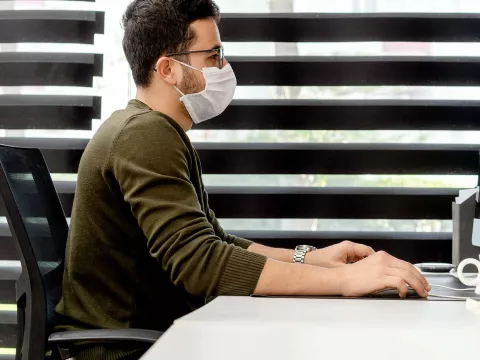- AdventHealth Centra Care

With the spread of coronavirus, many states have ordered nonessential businesses to close temporarily. But if your job is in an area that’s deemed essential — like health care, postal delivery or supermarket retail — you may still be reporting for work. Here’s what you need to know to stay safe while at work.
Protecting Yourself in Any Work Environment
If your workweek routine is still business as usual, the best way to avoid contracting coronavirus is to follow the Centers for Disease Control and Prevention (CDC) guidelines for protecting yourself in public.
The CDC says that coronavirus is typically spread from person to person through a sneeze or cough. People generally have to be within roughly 6 feet of one another for the virus to be transmitted.
To protect yourself, get in the habit of following these tips:
- Avoid contact with people who are sick
- Avoid touching your eyes, nose and mouth
- Cough or sneeze into a tissue, or your elbow if you don’t have tissues
- Use a hand sanitizer with at least 60% alcohol
- Wash your hands often with soap and water for at least 20 seconds, especially after blowing your nose, sneezing or coughing
- Stay at least 6 feet apart from others if coronavirus is spreading in your community
To protect others in your workplace, stay home if you are sick or have coronavirus symptoms.
How to Protect Yourself in an Office Setting
If you’re an essential office employee, stay at least 6 feet away from others in the workplace. In-person meetings should be moved to another format, but if you must meet face-to-face, use a large room with 6 feet of distance between yourself and others. Make the meeting as short as possible.
Keep your office space germ-free by cleaning and disinfecting high-touch surfaces, such as workstations, keyboards, handrails, doorknobs and phones. Use soap and water to clean if these items are dirty before disinfecting. Double-check all products to ensure they meet the EPA’s criteria for use against coronavirus.
Additionally, it’s a good idea to avoid touching other employees’ workstations, phones or tools. If you must use someone else’s desk or devices, clean and disinfect before and after you use it.
How to Protect Yourself if You Work in Health Care
As a health care worker, your interactions with people are at much closer proximity than most other employees, which means you need to take extra precautions.
Wear Your Personal Protective Equipment
First, follow the general workplace guidelines from the CDC mentioned above. In addition, your employer should provide specific guidance on the use of personal protective equipment (PPE) in caring for patients. Some PPE essentials include:
- Face masks
- Face shields
- Gloves
- Goggles
- Respiratory protection, when appropriate
While PPE can prevent some exposures, the U.S. Department of Labor’s Occupational Safety and Health Administration (OSHA) says that it “should not take the place of other prevention strategies.”
Remember: Select your PPE based on the hazards you’re exposed to at work. Make sure each item fits correctly and gets refitted as needed. Your PPE should be worn consistently, inspected regularly, maintained and replaced when necessary.
It’s crucial to remove, clean, store and dispose of PPE as required. This helps prevent them from contaminating yourself, others and the environment.
The CDC and OSHA specifically recommend that health care workers wear:
• Eye/face protection, such as goggles or face shields
• Gloves
• Gowns
• National Institute for Occupational Safety and Health (NIOSH)-certified disposable N95 respirators, if available
There are currently reported shortages of PPE in the United States, in particular, N95 respirators, surgical face masks and gowns. The CDC recommends that in times of shortage, alternatives to N95 respirators should be considered. Consult with your supervisor and workplace to determine the best approach for your situation.
The CDC also recommends that health care workers follow various levels of precautions depending on the kinds of patients they’re working with. For more detailed information, visit their Infection Control page.
And to learn more about OSHA’s guidance for workplaces that may expose workers to coronavirus, see their standards page.
How to Protect Yourself as a Delivery Person or Rideshare Driver
Rideshare drivers, as well as those who deliver groceries, mail or packages, may feel particularly at risk during this time.
Both Lyft and Uber recommend that drivers follow the CDC’s guidelines above for preventing infection in workplaces. Lyft is supplying drivers with hand sanitizer and cleaning supplies. As a driver, if you do get sick with COVID-19, the company is providing funds to help with missed work.
Uber recommends cleaning and disinfecting your vehicle, particularly the surfaces that you and passengers touch frequently. Cleaning should be done with soap and water, and disinfecting should be done with an EPA-approved cleaner.
On Lyft’s COVID-19 updates for drivers page, they echo the CDC’s guidance and recommend that drivers wear a simple cloth face covering to slow the spread of the virus. These face coverings can be made easily from low-cost supplies at home.
Many delivery companies are now offering contact-free delivery services, which will help protect both delivery drivers and customers.
How to Protect Yourself if You Work in Food Service
For those who work in a supermarket or grocery store, it’s likely that you will come into contact with many high-touch surfaces, like cash registers, touch screens and countertops.
Follow the general CDC guidance above for staying safe in public spaces and in the workplace. Clean and disinfect high-touch surfaces as frequently as possible. If you can’t wash your hands between helping customers, use an alcohol-based hand sanitizer as a substitute.
Some stores are installing plexiglass or glass barriers at checkout to help protect cashiers and customers. If these are unavailable at your workplace, stand as far away from customers as possible while still serving them like you normally would.
Know Your Rights as an Employee
If you’re at a high risk of severe illness from coronavirus, or have a disability, your employer may be required to provide you with reasonable accommodations due to coronavirus, such as telecommuting. Legal Aid at Work has more detailed information about what accommodations may be available.
The Families First Coronavirus Response Act has expanded family and medical leave rights for reasons related to coronavirus. If you do need to take time off work, check on what type of leave is now available to you and whether the act covers you.
Be Informed and Feel Empowered to Take Care of Yourself
To stay up to date with the latest coverage on coronavirus from sources you can trust. And for information on how to protect yourself and others, visit our Coronavirus Resource Hub.





